Opinion
The Vatican’s Pavilion at the Venice Biennale Is Set Inside a Women’s Prison. Who Is It Really For?
We took a trip inside the Holy See's exhibition, which includes pieces by Maurizio Cattelan, Claire Fontaine, and more.
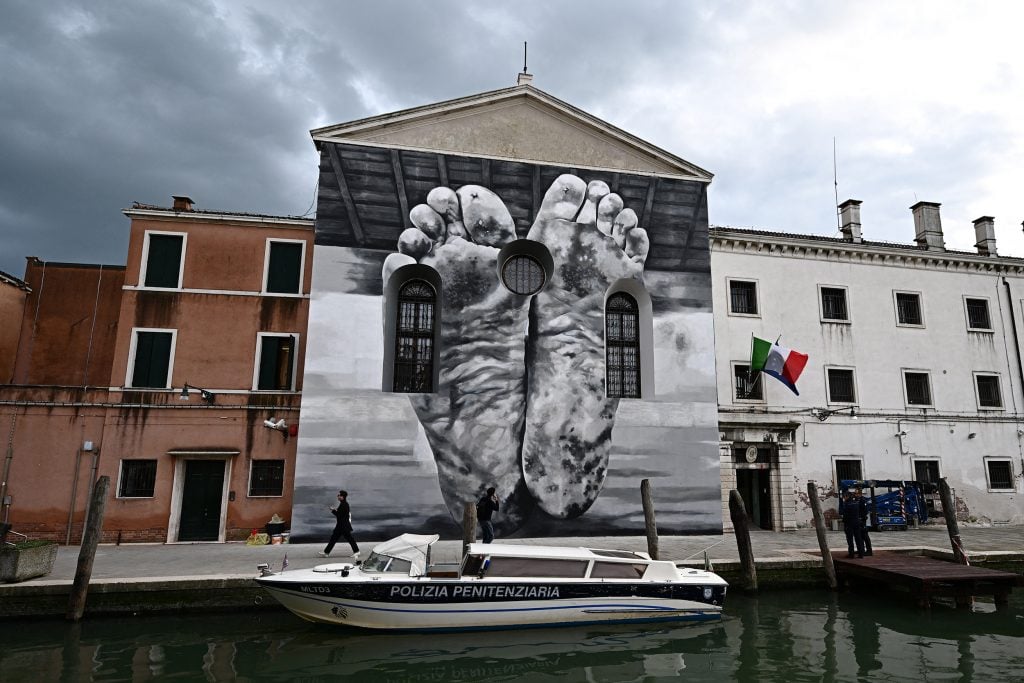
We took a trip inside the Holy See's exhibition, which includes pieces by Maurizio Cattelan, Claire Fontaine, and more.

Naomi Rea

As I surrendered my mobile phone to a police officer at the women’s detention center on Giudecca island, and submitted to being scanned with a handheld metal detector, I felt suddenly grateful for the freedom of the press. I have no qualms stating that I recoiled when I heard that the Vatican was using a functioning women’s prison as the backdrop for its pavilion at the Venice Biennale.
For all of the national posturing and virtue signaling that typically pervade the biennale, the idea felt more than usually grotesque. While art can, of course, bring about positive enrichment to incarcerated people, the limited autonomy and agency they have over their lives raises ethical concerns about the dynamics in play here. As if involuntarily submitting to state power wasn’t enough, one of the world’s most influential art organizations and one of its largest religious institutions is in the mix.
A lot of air was given by the press representatives to the pavilion presenting a wonderful opportunity for these women to view artworks picked by star curators Chiara Parisi and Bruno Racine, by famous artists including Maurizio Cattelan, and even for them to meet celebrities like Zoë Saldaña. Oh, and they have a papal visit to look forward to, as well. But little was said of what was being done by this project to address their broader needs and rights.
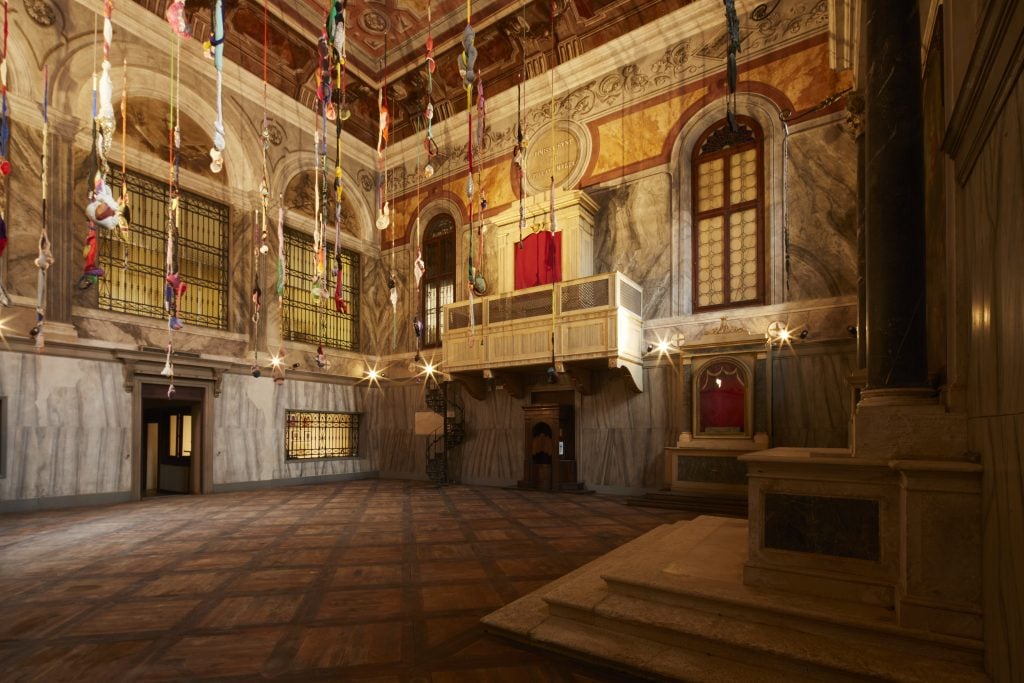
Installation view of Sonia Gomes piece at Pavilion of the Holy See, 60th International Art Exhibition – La Biennale di Venezia, With my eyes. Photo by Marco Cremascoli.
This issue was turning in my mind as I headed into the show, titled “With My Eyes,” with tours being conducted by the prison residents. I asked one of my tour guides, Silvia, who did not want to share her surname for privacy reasons, and she welcomed the biennale’s intervention in the prison as something to break up the monotony. “We are accustomed to ugly things; this is something beautiful,” she said.
Despite the ostensibly willing participation of my tour guide, as other members of the press thrust cameras and microphones into their faces, I couldn’t help but wonder: Who is all this for? The Vatican—officially the Holy See—says it intends to promote “a culture of encounter” to draw attention to our “intertwining stories” with the incarcerated, because “they tell of the same hunger for love, the same desire for life, for affection, the same restlessness for meaning, everything that art has always sought to reflect and represent.”
Liri Longo, a former president of the Rio Terà dei Pensieri cooperative, which organizes artisanal workshops in prisons in Venice, including at the Giudecca institution, said she has mixed feelings about the project.
“Art can be a big opportunity for people in prison to find new perspectives, to live good experiences, to express themselves, and to get in touch with new people and ideas,” she said. “But to truly allow people to participate in the process is something that takes a long time, not just one month. If I’m being sincere, we feel the way it has been managed is quite unfair. It is something that was imposed on the people in the prison without really involving them.”
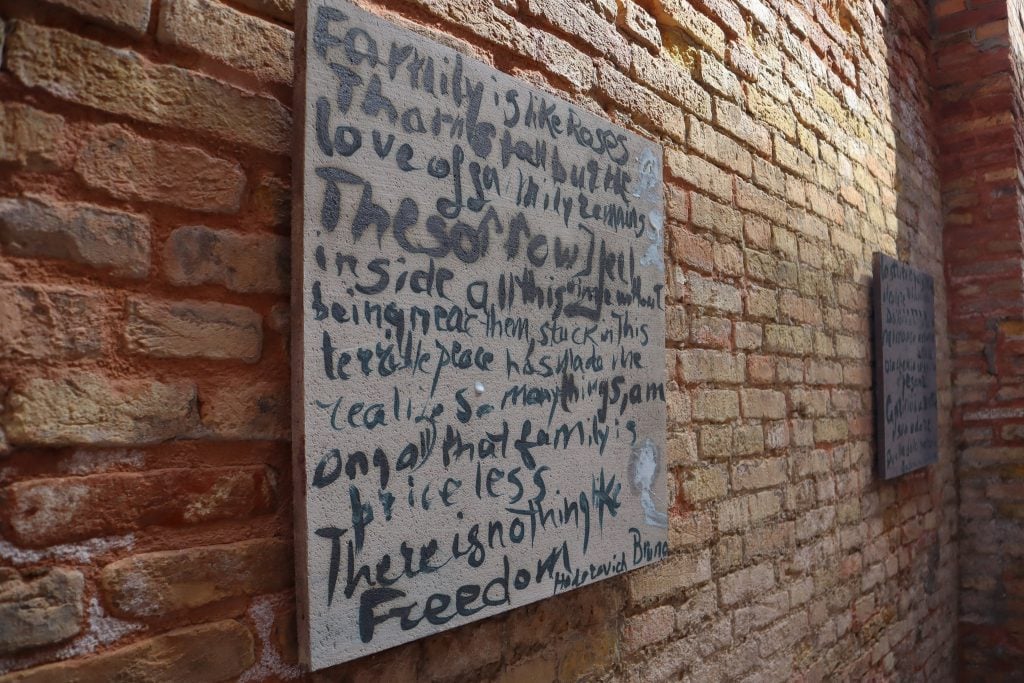
Simone Fattal work. Photo: Naomi Rea.
Which is not to say that there weren’t sincere attempts by the artists to engage with the women in the institution. In a walkway between the prison and the outside walls, the Damascus-born artist Simone Fattal has created a series of lava stone paintings scrawled with lines of poetry written by the women. French artist Claire Tabouret painted stylized portraits based on photographs of their children for an interior room. A lyrical installation by the Italian-British artist duo Claire Fontaine takes a central place in the prison’s courtyard with a comforting message: “siamo con voi nella notte“—”we are with you through the night.”
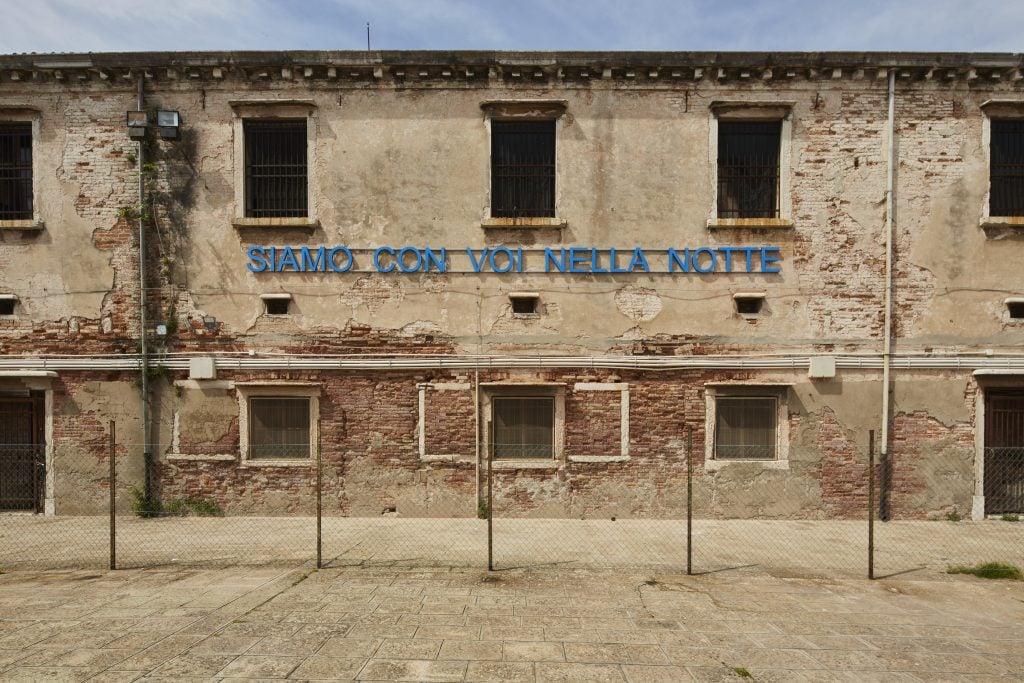
Installation view of Claire Fontaine piece at Pavilion of the Holy See, 60th International Art Exhibition – La Biennale di Venezia, With my eyes. Photo by Marco Cremascoli.
“We are really coming from a place to try to make something so they can be seen, they can be heard,” Italian artist Marco Perego told me in a phone interview. Perego has directed a film starring Saldaña, who is his wife, as an incarcerated person on her last day in prison, working onsite with 21 of the residents as her costars. He viewed it as a true collaboration, he said. “When I was explaining the story, some of the women came forward and said, ‘I really want to do this because I feel very invisible to the outside world.”
Yet, as honorable as his intentions may have been, the 17-minute short feels self-indulgent. If Perego meant to depict the women with dignity, why is the first woman to appear in the film, other than Saldaña, sitting on a toilet? Shortly afterward, there is a gratuitous shower scene during which a (fully clothed) Saldaña hands a bar of soap to one of the naked women. In another scene, an incoming resident is manhandled and strip searched, as she sobs. On top of that, there’s some glib religious messaging. We learn the name of the Saldaña character as she picks up her effects, before she exits: “A. Rosario”—a rosary.
As I emerged into the prison’s garden after the film, I asked one of its stars, Giulia, what she thought of it. She said she was still processing her emotions, but judged it “bellissima.” It is lucky that she found it beautiful, because she was not given an opportunity to see the film before it was shown to the public.
I asked Saldaña ahead of the opening about the possibility that the project could be exploiting these women. “I am not involved with the politics. I’m not involved with the production,” she said. “That would have detached me from the work that I was there to do. I handled it no differently than any other sort of film set.” She added that she viewed working with the Holy See as akin to working with “a brand that sponsors your content.”
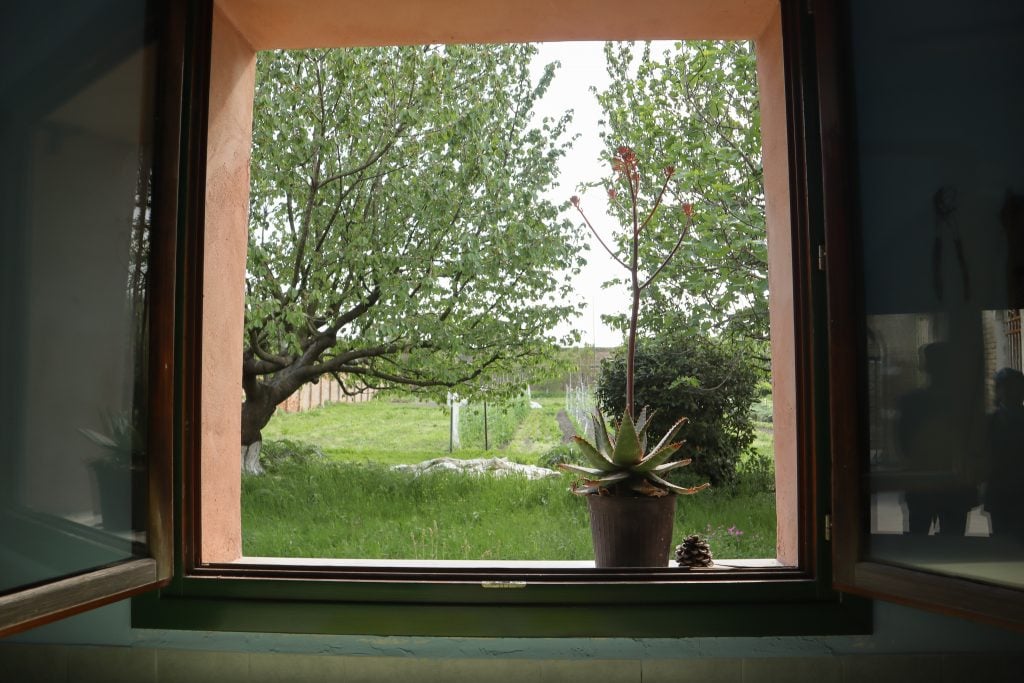
An open window looking out into the garden of the Giudecca women’s prison. Photo: Naomi Rea.
Pope Francis will visit the pavilion on April 28, becoming the first pontiff in history to attend the biennale. And while a papal visit could be a powerful symbol of compassion and solidarity, let’s not forget that the biennale is a site for all sorts of soft-power plays and branding exercises. Here, the artists get a place in the prestigious biennale program, and the Vatican gets to signal itself as a relevant and progressive institution, capable of addressing the pressing challenges of the modern world. But what do the residents really get, in the end?
What comes after these words of comfort and encouragement fade away? What are the consequences of creating this spectacle on the mental health of the residents? Without making any sustained commitment to supporting these women, the project feels as empty as the climate change statements being made by the organizers of other national pavilions while they leave a hefty carbon footprint on a sinking city.
Saldaña acknowledged the critique, but presented an alternate view. “Do you find it also problematic to host such a big event every two years in such a great city … and never have one conversation about this institution of women?” she asked. “You have to be wise to understand the complexity of conversations and topics in the world and still make a decision to participate in a very positive way, as opposed to not ever touching them.”
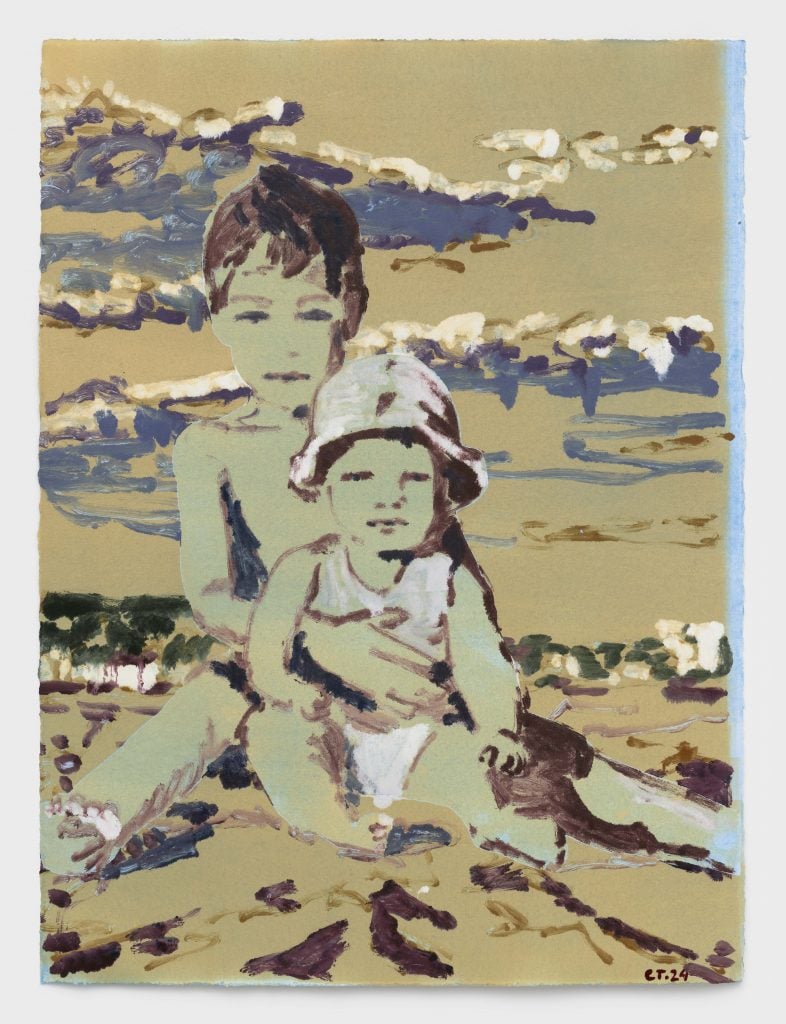
One of Claire Tabouret’s paintings. Photo by Marten Elder, Courtesy of the artist and Almine Rech.
If the residents are hoping for some visibility for the issues that matter to them, you can look around for some hints. Getting to see their families, and feeling human touch, are recurring themes in Fattal’s poetic works. In the central courtyard, underneath the Claire Fontaine piece, a tree is wrapped in a colorful crochet patchwork, and hung with a banner that reads “no alle violenzia sulle donne”—”no to violence against women.” (This is not a part of the biennial show.) While conducting her tour, Giulia pointed to a window looking out into the prison’s vegetable garden. It’s her favorite, as it’s the only one in the prison that does not have bars on it.
As we were ushered outside the prison at the end of the tour I looked back up at the facade of the building, where Maurizio Cattelan has painted a building-sized mural of the soles of his own dirty feet. It evokes the religious rite of foot washing practiced by church leaders in imitation of Jesus’s selfless love. In 2016, Pope Francis changed the Roman Missal to permit the washing of women’s feet.
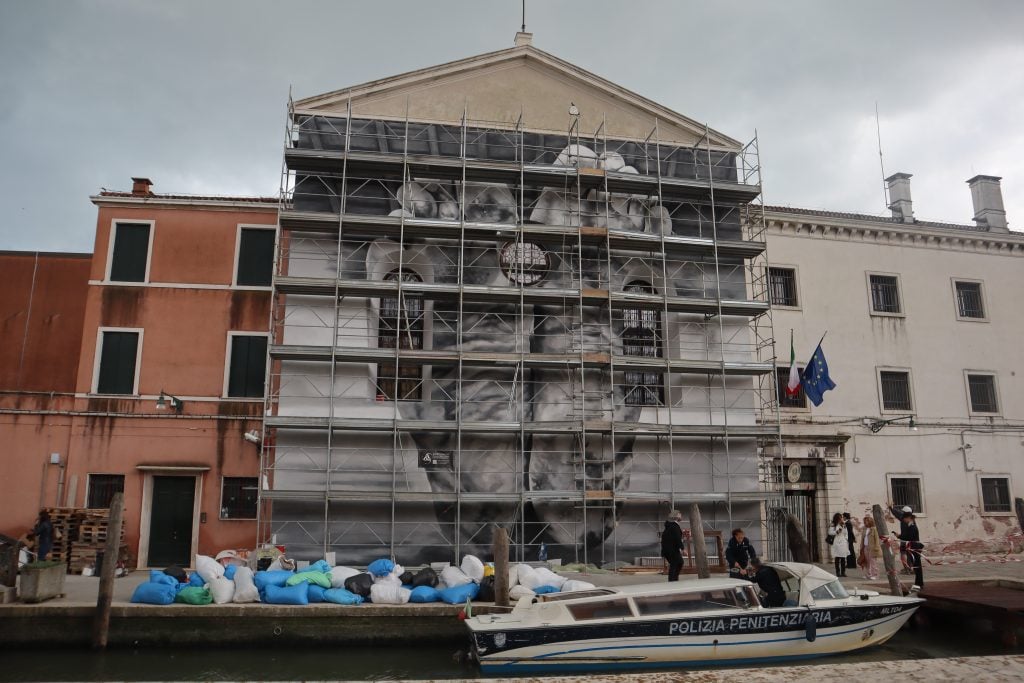
Maurizio Cattelan, Father (2024). Photo: Naomi Rea.
While some may interpret Cattelan’s work as a sincere gesture toward the pontiff’s more progressive politics, his history of iconoclasm may suggest deeper layers of irony. In the 1999 biennale, he famously showed a wax sculpture of Pope John Paul II after being struck down by a meteorite. Notice the artist’s decision to make this intervention on the outside of the prison, a space inaccessible to its residents.
“With My Eyes. Holy See Pavilion” is on view through November 24 at the Guidecca Women’s Detention Home in Venice.